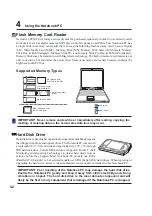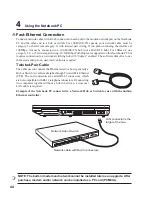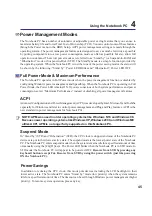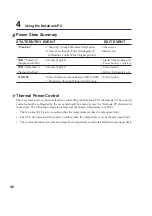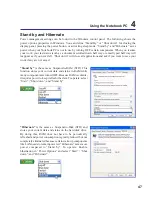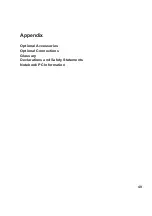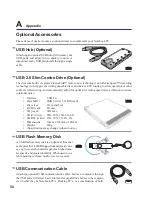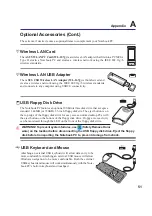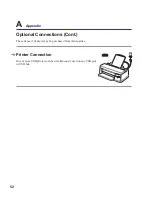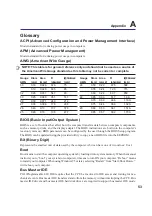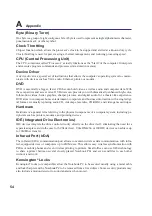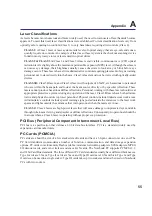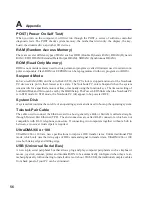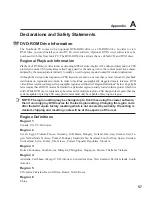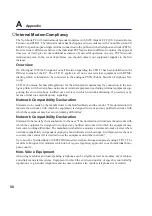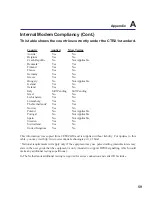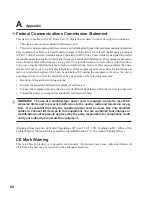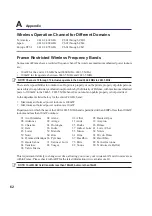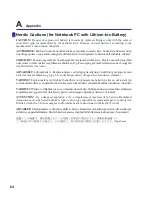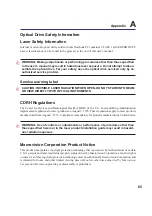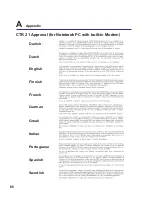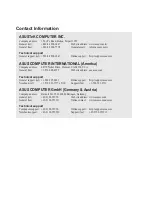
56
A
Appendix
POST (Power On Self Test)
When you turn on the computer, it will first run through the POST, a series of software-controlled
diagnostic tests. The POST checks system memory, the motherboard circuitry, the display, the key-
board, the diskette drive, and other I/O devices.
RAM (Random Access Memory)
There are several different types of RAM such as DDR (Double Dynamic RAM), DRAM (Dynamic
RAM), EDO DRAM (Extended Data Output DRAM), SDRAM (Synchronous DRAM).
ROM (Read Only Memory)
ROM is nonvolatile memory used to store permanent programs (called firmware) used in certain com-
puter components. Flash ROM (or EEPROM) can be reprogrammed with new programs (or BIOS).
Suspend Mode
In Save-to-RAM (STR) and Save-to-Disk (STD), the CPU clock is stopped and most of the Notebook
PC devices are put in their lowest active state. The Notebook PC enters Suspend when the system
remains idle for a specified amount of time or manually using the function keys. The timeout setting of
both Hard Disk and Video can be set by the BIOS Setup. The Power LED blinks when the Notebook PC
is in STR mode. In STD mode, the Notebook PC will appear to be powered OFF.
System Disk
A system disk contains the core file of an operating system and is used to boot up the operating system.
Twisted-Pair Cable
The cable used to connect the Ethernet card to a host (generally a Hub or Switch) is called a straight-
through Twisted Pair Ethernet (TPE). The end connectors are called RJ-45 connectors, which are not
compatible with RJ-11 telephone connectors. If connecting two computers together without a hub in
between, a crossover twisted-pair is required.
UltraDMA/66 or 100
UltraDMA/66 or 100 are new specifications to improve IDE transfer rates. Unlike traditional PIO
mode, which only uses the rising edge of IDE command signal to transfer data, UltraDMA/66 or 100
uses both rising edge and falling edge.
USB (Universal Serial Bus)
A new 4-pin serial peripheral bus that allows plug and play computer peripherals such as keyboard,
mouse, joystick, scanner, printer and modem/ISDN to be automatically configured when they are at-
tached physically without having to install drivers or reboot. With USB, the traditional complex cables
from back panel of your PC can be eliminated.
Summary of Contents for Z94G
Page 1: ...Notebook PC Hardware User s Manual E2219 Nov 2005 ...
Page 4: ...4 Contents ...
Page 10: ...10 1 Introducing the Notebook PC ...
Page 11: ...11 2 Knowing the Parts Basic sides of the Notebook PC ...
Page 32: ...32 3 Getting Started ...
Page 48: ...48 4 Using the Notebook PC ...
Page 67: ...67 Appendix A ...

